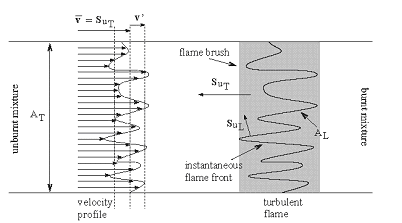
|
BRHS /
Interaction between turbulence and flames: turbulent burning velocityAs if follows from the title a turbulent combustion is affected/dominated by the turbulence-chemistry interaction. The turbulence can promote the combustion by two main mechanisms: the larger turbulent length scales are capable of increasing the wrinkling of the flame, increasing the flame surface area and therefore the fuel consumption rate. If the Kolmogorov length scale of the flow is smaller than the flame thickness, the turbulence is also able to modify the inner flame structure, increasing the transport rate of heat and matter across the flame itself. It must be pointed out that in some cases turbulence decreases the combustion rate and it can even cause the quenching of the flame. Being the coupling between turbulence and chemistry a two way coupling, also the combustion affects the turbulent field. Across the flame, because of the heat release, a strong acceleration of the flow occurs, producing the so-called “flame generated turbulence”. Moreover the increase of temperature across the flame enhances the gas kinematic viscosity, damping the turbulence (relaminarization due to combustion).  Figure 1. Turbulent burning velocity. To expose the features of turbulent flame propagation, it is helpful to consider laminar flame propagation briefly. When a flame is stabilised in a laminar flow of combustibles, it establishes itself at a fixed position in the flow field and its surface remains smooth. In other words, it inherits the laminar behaviour of the flow field. Moreover, the velocity at which the cold reactants enter the flame zone in the normal direction, the laminar burning velocity, appears to be a mixture specific property. It reflects the sensitivity of the combustion process to changes in the chemical composition, fuel concentration, oxygen content, pressure and temperature of the reactants. By contrast, when a laminar flame becomes trapped within a turbulent flow of combustibles, it inherits the turbulent nature of the flow field: the turbulence of the approaching flow continuously distorts the flame and ceaselessly shifts its position in space between certain geometrical boundaries. As a result, the surface area of the instantaneous laminar flame changes in a chaotic manner, which is determined by the turbulence of the flow field. The geometrical boundaries between which the instantaneous flame front shifts its position are identified as a turbulent flame thickness. A superposition of many instantaneous flame surfaces results in a time-averaged picture that is frequently referred to as the turbulent flame brush, and inspired the definition of a turbulent burning velocity by analogy with the laminar burning velocity. Due to the enhancement of heat and mass transfer by turbulence, the turbulent flame brush propagates with a turbulent burning velocity that is greater than the laminar burning velocity. The local consumption of reactants at any particular portion of the flame surface, however, occurs within a zone whose width is equal to the local laminar flame thickness and at a rate which is determined by the local laminar burning velocity. In the case of large scale, low intensity turbulence, the instantaneous flame front will be wrinkled while the transport properties remain the same. The wrinkles increase the flame front area per unit cross section of the turbulent flame brush which results in a higher propagation velocity without a change in the instantaneous local flame structure itself. The instantaneous flame surfaces in such a turbulent flame are known as laminar flamelets. With this picture in mind, Damkohler and Schelkin derived the earliest models for the turbulent burning velocity. These authors and later Karlovitz demonsterated that turbulent flame speed is defined byz the level of turbulence. Damkohler G. NACA Tech. Memo 1112, National Advisory Committee for Aeronautics, Washington, 1947. Original: Z. Elektrochem., vol. 46, 1940, pp. 601. << Turbulence scales | Content | Borghi-diagram and interpretation of combustion regimes >> |